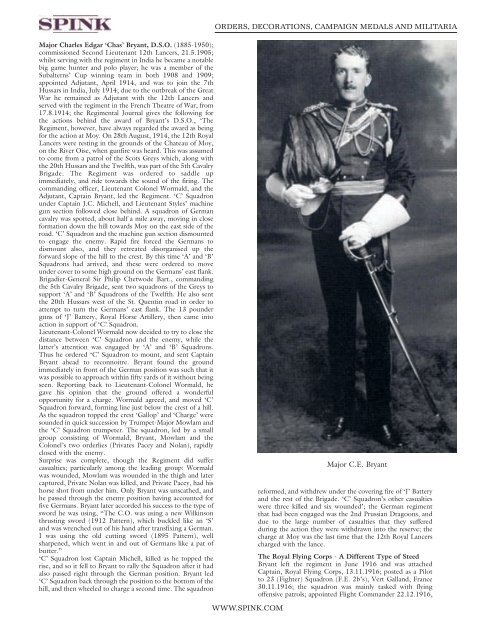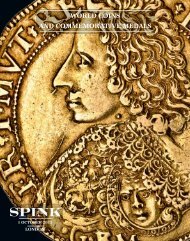orders, decorations, campaign medals and militaria - Spink
orders, decorations, campaign medals and militaria - Spink
orders, decorations, campaign medals and militaria - Spink
Create successful ePaper yourself
Turn your PDF publications into a flip-book with our unique Google optimized e-Paper software.
Major Charles Edgar ‘Chas’ Bryant, D.S.O. (1885-1950);<br />
commissioned Second Lieutenant 12th Lancers, 21.5.1905;<br />
whilst serving with the regiment in India he became a notable<br />
big game hunter <strong>and</strong> polo player; he was a member of the<br />
Subalterns’ Cup winning team in both 1908 <strong>and</strong> 1909;<br />
appointed Adjutant, April 1914, <strong>and</strong> was to join the 7th<br />
Hussars in India, July 1914; due to the outbreak of the Great<br />
War he remained as Adjutant with the 12th Lancers <strong>and</strong><br />
served with the regiment in the French Theatre of War, from<br />
17.8.1914; the Regimental Journal gives the following for<br />
the actions behind the award of Bryant’s D.S.O., ‘The<br />
Regiment, however, have always regarded the award as being<br />
for the action at Moy. On 28th August, 1914, the 12th Royal<br />
Lancers were resting in the grounds of the Chateau of Moy,<br />
on the River Oise, when gunfire was heard. This was assumed<br />
to come from a patrol of the Scots Greys which, along with<br />
the 20th Hussars <strong>and</strong> the Twelfth, was part of the 5th Cavalry<br />
Brigade. The Regiment was ordered to saddle up<br />
immediately, <strong>and</strong> ride towards the sound of the firing. The<br />
comm<strong>and</strong>ing officer, Lieutenant Colonel Wormald, <strong>and</strong> the<br />
Adjutant, Captain Bryant, led the Regiment. ‘C’ Squadron<br />
under Captain J.C. Michell, <strong>and</strong> Lieutenant Styles’ machine<br />
gun section followed close behind. A squadron of German<br />
cavalry was spotted, about half a mile away, moving in close<br />
formation down the hill towards Moy on the east side of the<br />
road. ‘C’ Squadron <strong>and</strong> the machine gun section dismounted<br />
to engage the enemy. Rapid fire forced the Germans to<br />
dismount also, <strong>and</strong> they retreated disorganised up the<br />
forward slope of the hill to the crest. By this time ‘A’ <strong>and</strong> ‘B’<br />
Squadrons had arrived, <strong>and</strong> these were ordered to move<br />
under cover to some high ground on the Germans’ east flank.<br />
Brigadier-General Sir Philip Chetwode Bart., comm<strong>and</strong>ing<br />
the 5th Cavalry Brigade, sent two squadrons of the Greys to<br />
support ‘A’ <strong>and</strong> ‘B’ Squadrons of the Twelfth. He also sent<br />
the 20th Hussars west of the St. Quentin road in order to<br />
attempt to turn the Germans’ east flank. The 13 pounder<br />
guns of ‘J’ Battery, Royal Horse Artillery, then came into<br />
action in support of ‘C’ Squadron.<br />
Lieutenant-Colonel Wormald now decided to try to close the<br />
distance between ‘C’ Squadron <strong>and</strong> the enemy, while the<br />
latter’s attention was engaged by ‘A’ <strong>and</strong> ‘B’ Squadrons.<br />
Thus he ordered ‘C’ Squadron to mount, <strong>and</strong> sent Captain<br />
Bryant ahead to reconnoitre. Bryant found the ground<br />
immediately in front of the German position was such that it<br />
was possible to approach within fifty yards of it without being<br />
seen. Reporting back to Lieutenant-Colonel Wormald, he<br />
gave his opinion that the ground offered a wonderful<br />
opportunity for a charge. Wormald agreed, <strong>and</strong> moved ‘C’<br />
Squadron forward, forming line just below the crest of a hill.<br />
As the squadron topped the crest ‘Gallop’ <strong>and</strong> ‘Charge’ were<br />
sounded in quick succession by Trumpet-Major Mowlam <strong>and</strong><br />
the ‘C’ Squadron trumpeter. The squadron, led by a small<br />
group consisting of Wormald, Bryant, Mowlam <strong>and</strong> the<br />
Colonel’s two orderlies (Privates Pacey <strong>and</strong> Nolan), rapidly<br />
closed with the enemy.<br />
Surprise was complete, though the Regiment did suffer<br />
casualties; particularly among the leading group: Wormald<br />
was wounded, Mowlam was wounded in the thigh <strong>and</strong> later<br />
captured, Private Nolan was killed, <strong>and</strong> Private Pacey, had his<br />
horse shot from under him. Only Bryant was unscathed, <strong>and</strong><br />
he passed through the enemy position having accounted for<br />
five Germans. Bryant later accorded his success to the type of<br />
sword he was using, “The C.O. was using a new Wilkinson<br />
thrusting sword (1912 Pattern), which buckled like an ‘S’<br />
<strong>and</strong> was wrenched out of his h<strong>and</strong> after transfixing a German.<br />
I was using the old cutting sword (1895 Pattern), well<br />
sharpened, which went in <strong>and</strong> out of Germans like a pat of<br />
butter.”<br />
‘C’ Squadron lost Captain Michell, killed as he topped the<br />
rise, <strong>and</strong> so it fell to Bryant to rally the Squadron after it had<br />
also passed right through the German position. Bryant led<br />
‘C’ Squadron back through the position to the bottom of the<br />
hill, <strong>and</strong> then wheeled to charge a second time. The squadron<br />
<strong>orders</strong>, deCoratioNs, CampaigN medaLs aNd miLitaria<br />
WWW.spiNK.Com<br />
Major C.E. Bryant<br />
reformed, <strong>and</strong> withdrew under the covering fire of ‘J’ Battery<br />
<strong>and</strong> the rest of the Brigade. ‘C’ Squadron’s other casualties<br />
were three killed <strong>and</strong> six wounded’; the German regiment<br />
that had been engaged was the 2nd Prussian Dragoons, <strong>and</strong><br />
due to the large number of casualties that they suffered<br />
during the action they were withdrawn into the reserve; the<br />
charge at Moy was the last time that the 12th Royal Lancers<br />
charged with the lance.<br />
The Royal Flying Corps - A Different Type of Steed<br />
Bryant left the regiment in June 1916 <strong>and</strong> was attached<br />
Captain, Royal Flying Corps, 13.11.1916; posted as a Pilot<br />
to 23 (Fighter) Squadron (F.E. 2b’s), Vert Gall<strong>and</strong>, France<br />
30.11.1916; the squadron was mainly tasked with flying<br />
offensive patrols; appointed Flight Comm<strong>and</strong>er 22.12.1916,

















